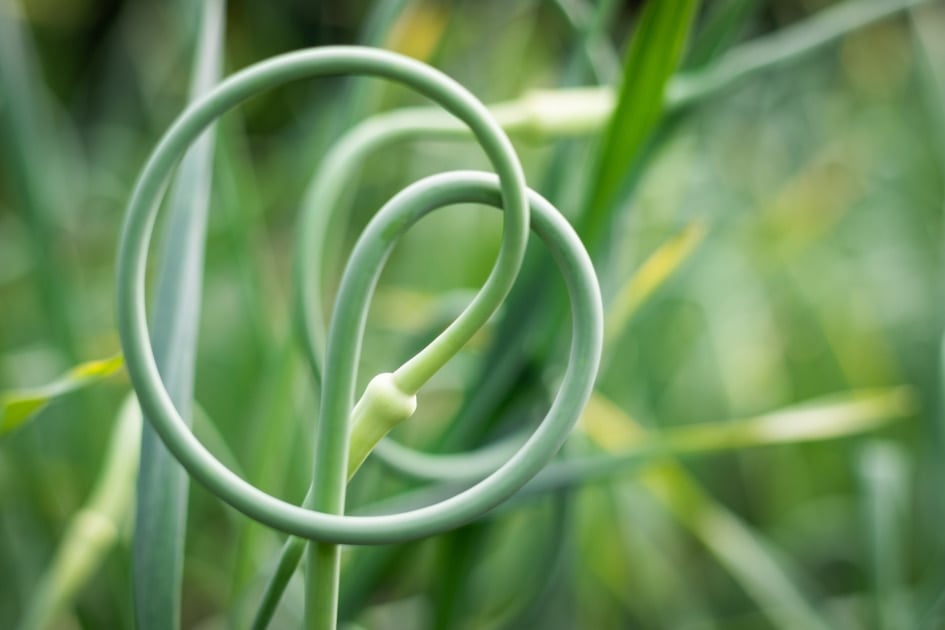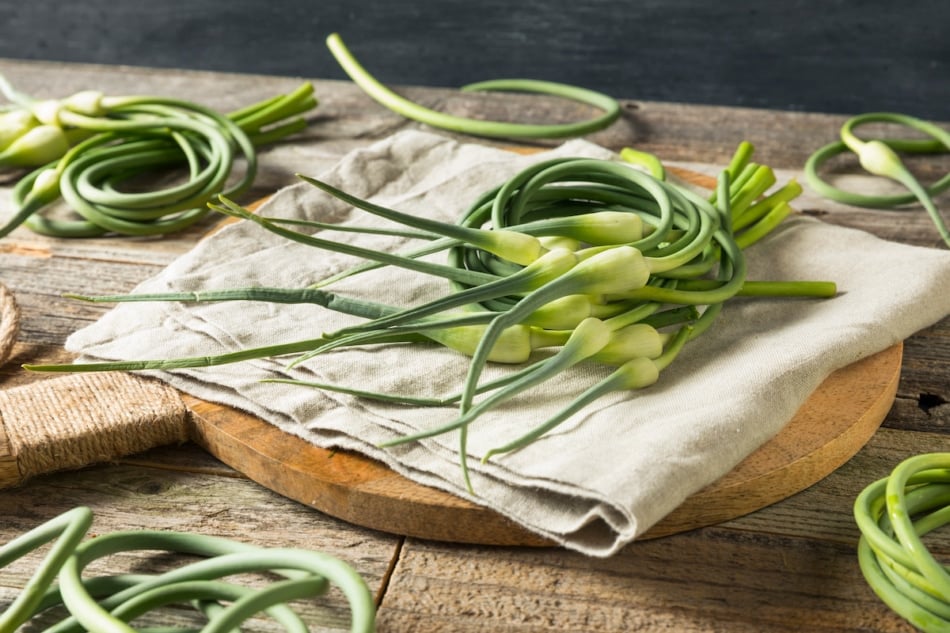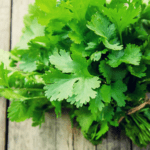What The Heck Are Garlic Scapes?
Garlic scapes are only available for a short time in late spring and early summer. Learn when to harvest your own, and enjoy these 3 delicious recipes!

Used to add flavor to a wide variety of dishes, garlic is one of the most popular flavors on the culinary scene. But did you know that the bulbous garlic root isn’t the only edible part of the plant? The green shoots, or stems, that grow from those roots—more properly known as garlic scapes—are also edible, and are a staple on the tables of backyard gardeners and farmers’ market shoppers.
What Are Garlic Scapes?

Sprouting out of the ground in late spring, garlic scapes are thin, curly, green stems, resembling grass or wild onions. Growers cut them off to allow more of the plant’s resources to stay focused within the bulb. Young ones are tender and delicious. They generally have a milder taste than the cloves, similar to shallots or chives. They can be diced up finely and added to various dishes for extra flavor, or sautéed in olive oil and enjoyed on their own.
Curling garlic scape tendrils often include a bulge in the middle. This is the unopened flower of the plant. It is also edible, though not as tender as the rest of the stem. Some people cut it off and discard it, while others simply eat it.
Are There Health Benefits in Garlic Scapes?
Garlic scapes are a good source of protein, vitamin C, and calcium and, like garlic cloves, can help to prevent heart disease, high cholesterol, high blood pressure, and cancer. They can also provide immune system support and reduce inflammation.
Where Can You Get Garlic Scapes?

Garlic scapes are only available for a short window of time in late spring and early summer, available at most farmers’ markets. You can even buy them online. It’s OK to store your garlic scapes in the fridge, where they’ll stay fresh for up to 3 weeks. They can also be frozen.
Harvesting Your Own

If you are growing garlic and you want big, flavorful bulbs, you’ll want to cut off the scapes as they emerge in early summer, before the plant flowers. The reason for this is so that the plant can put its energy in the bulb rather than the flowers that will emerge.
Here are a few tasty ways to enjoy this flavorful garlicky treat:
Sautéed Garlic Scapes

- Garlic ScapesOlive oil Salt and Pepper to taste
Place as many garlic scapes as you have, or will fit, into a large frying pan.
Drizzle with olive oil — just enough to coat each scape without pooling at the bottom of the pan.
Cook over medium heat, until the scapes start to brown.
Add salt and pepper to taste.
Garlic Scape Pesto

- 1 cup diced garlic scapes
- 1/3 cup pine nuts
- 3/4 cup olive oil
- 3/4 cup olive oil
- 1/2 teaspoon salt and black pepper to taste
Blend all ingredients together with a food processor or high-speed blender.
Garlic Scape Pizza

- 1 lb. whole-wheat pizza dough
- 1 cup pizza sauce
- 1 cup mozzarella cheese
- 6 garlic scapes
- olive oil
Allow pizza dough to sit and rise until it stretches easily.
Preheat your oven to 450° F.
Brush a large cookie sheet with olive oil and fit the dough to the pan.
Cover the dough with pizza sauce and top with cheese.
Cut the garlic scapes into 3” segments and place evenly over the cheese.
Bake for 15-18 minutes, until the crust is golden brown and the cheese is bubbly.

Jaime McLeod
Jaime McLeod is a longtime journalist who has written for a wide variety of newspapers, magazines, and websites, including MTV.com. She enjoys the outdoors, growing and eating organic food, and is interested in all aspects of natural wellness.












Growing garlic in clay will make it stronger.
bury an old plastic container with the bottom
cut out. Fill with 60soil / 40 clay cat litter.
the garlic is contained and in optimal soil.
We regularly pick and eat wild garlic scapes, sautéed in butter. They are lovely as a side dish with meats and fish, and they’re FREE!!
Nelline, if you live where garlic will grow plant your cloves a couple of weeks before freezing. You want the cloves to sprout but not break the soil surface. Put lots of manure and a good covering of straw on your bed . In the spring the shoots will work their way up through the straw. You should also plant your own garlic year to year as it adapts to its own conditions.
As soon as the snow melts and the Rhubarb has pushed up, I lift the straw on my garlic patch looking for that first green shoot. Then I continue to watch it until sometime in mid June the scapes grow out. Once they make the turn, I harvest them. I make scape pesto and freeze a lot for those times in the winte when I need a reminder of spring. I also cook the stir fry the scapes to go in rice. They can be blanched and frozen.
We live at Lake of the Ozarks in Missouri. In the Spring we have what looks like chives growing EVERYWHERE. Cutting them down with the lawnmower emits a strong “garlic” odor. Are these edible? I often thought they would be good in salads and in cooking but was afraid to eat them!
They’re probably just wild onions. Garlic scapes are very long, very curly, and very fat. They don’t really look like chives at all. You can eat wild onions, absolutely, as long as you’re not treating your lawn with any harmful chemicals.
They are the best! Salivating as we speak! I use them in stir fry. Salads. Just about go in everything! I am gonna cut up and freeze for the winter. I actually look fwd to these,more than garlic it self.Maybe bc its spring! And no peeling.
Yum!
Onions are generally broken near the ground when flowering stalks appear, and this is supposed to fatten the bulbs. I imagine the same is true of garlic: let the young leaves stay on to build foodstores for the bulb, but as soon as you see signs of flowering, break or cut them off. Garlic, and some onions, form bulbils in the flowerhead, and you don’t want energy diverted there. It is very difficult to get any Allium to bulb in peninsular Florida, however.
Great growing hint about cutting the scapes off to send more energy to the bulb. I’ll have to remember that next growing season. I wonder if the same would work for onions?
Nelline, if you are in Zone 9 or warmer, garlic won’t bulb, and it won’t even love long. Try using Tulbaghia (society garlic) scapes. If you live in Zone 8 or cooler, check one of the more extensive catalogs for different varieties of garlic. Generally, hardnecks require more chill than softnecks. Also, call your local agricultural extension and see what they recommend. Plant when the moon is on the decrease, and make sure your plants are getting enough phosphorus.
Only HARDNECK garlic will grow scapes (they eventually turn into hard necks and a flower head). There are many varieties of hardneck garlic
I have some garlic plants that do not make big bulbs of garlic can you tell me what i need to do to help them grow?Are you suppose to pull the dirt away from them like you do potatoes?Thanks.NElline.
Plant them in the Fall. I live is zone 3-4 we plant in October and harvest the next September, my garlic scapes are ready now.
I live in zone 3b. I recently read that fall planted garlic should be ready to harvest 4-6 weeks after the appearance of the scapes. That would mean harvesting my fall planted garlic into mid-late July, since I’ve had scapes for about a week now on some of my garlic. Isn’t September the time to harvest spring planted garlic? Certainly not saying your wrong, I’m just confused. Thank you for any further information you can share about harvesting garlic.
Depending on where you live, most garlic planted in the Fall will be ready to harvest in July or August. Warmer climates could be as early as June. The best way to tell if your garlic is ready is to wait until the bottom 2 or 3 leaves are yellowed or have turned brown. This will make sure your garlic has enough paper protection to dry for the upcoming winter.
Wild garlic can be any number of native or escaped species, but yes, their scapes are edible. Test for strength. If this species is fairly mild, use it like garlic chives. If it’s stronger, see what amount of cooking brings it to the desired strength. Strong-tasting kinds can also be used to infuse salad oil or simply rubbed on the bowl before making salad. They can also be minced and added to a hot soup or stew after the heat is turned off, about five minutes before serving.
Because true garlic is difficult to grow in peninsular Florida, many people use the leaves and flowers of Tulbaghia (society garlic) the same way. The flavor is both coarser and more fleeting than that of true garlic, and the method of adding it to a hot dish or drawn butter after the heat is off, five to ten minutes before serving, seems to hit the right balance. It also works well in marinades.